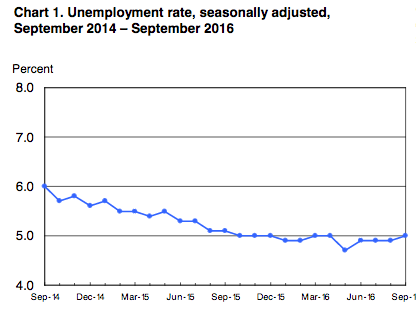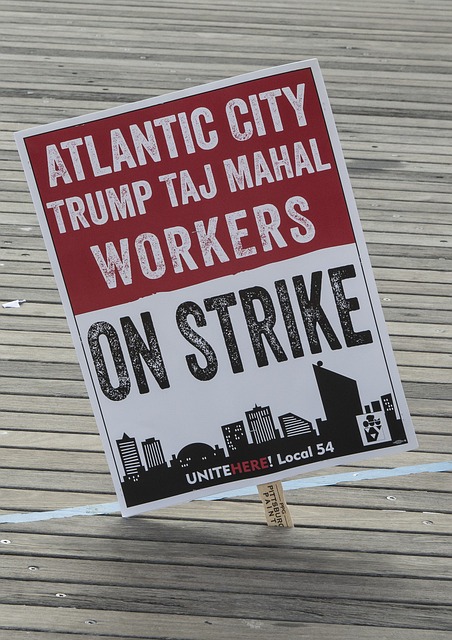Just How Bad Was the September Jobs Report?

Last night’s debate, Donald Trump, and the September jobs report
In last night’s third presidential debate, Republican candidate, Donald Trump called September’s job report “anemic,” “terrible,” and said that he will “win easily . . . it was so bad.” Beyond the wedge issues of the culture wars, such as gun control and abortion, the one thing all presidential candidates can agree on is improving the economy. What they don’t agree on, however, is how to achieve that economic improvement.
There seems to be little confidence in either candidate’s plans for continuing the economic recovery. During last night’s presidential debate, moderator Chris Wallace suggested that Hillary Clinton’s plan for job growth was too similar to Obama’s stimulus plan, which led to the lowest GDP growth since 1949. As for Trump’s plan to create 25 million jobs, Wallace commented that even conservative economists don’t think the numbers add up and that it is unrealistic.
With growing skepticism about either candidate’s ability to provide a meaningful plan for job growth and economic improvement, let’s take a look at the September 2016 Jobs Report released earlier this month by the Bureau of Labor Statistics.
Compared to last month’s job report, very little has changed. The unemployment rate measured this September hovered around 5.0%, which is about the same as it was the same month last year, but down 1 point from 6.0% during September 2014. In general, the unemployment rate hovered around 5% since August 2015.
This is relatively good news for those seeking a job or looking to change their career. In total, 156,000 new jobs were created, which is slightly less than what economic predictions forecasted. The industry with the largest job growth was professional and business services, where employment rose by 67,000. Following this, health care had the next highest job growth, increasing payroll by 33,000 jobs. Employment in most other major industries remained stagnant since August.
Another bit of good news is the increase in average hourly earnings for employees on private, non-farm payrolls. While the average hourly wage rose by only 6 cents since the previous month, over the year average hourly earnings have increased by 2.6%. While this may seem low, it is keeping up with sluggish inflation. As the labor market has become more competitive, more people have been re-entering the labor force. Labor-force participation had a small uptick since the previous month, increasing by 0.1%, but over the year has increased by 0.5%. This increase in participation helps explain why the unemployment rate has remained relatively steady over the year. Increases in job growth are drawing discouraged would-be workers back into the labor market.
Well the September jobs report was not exactly stellar, modest gains were generally made across the board. Wages are increasing, jobs are being added, and more people are being drawn into the work force. So why exactly was it so “terrible” according to Donald Trump?

In the Trump campaign’s press release on the September jobs report, Senior Economic Advisor, David Malpass draws attention to the millions of Americans being left out of the Obama economic recovery. In particular, Malpass focuses on the labor-force participation rate of 62.9%, which is near a historic low. While it is true that over 94 million Americans are out of the job market, economists at the Wall Street Journal suggest that this low rate is due mostly to an aging population and that it is not expected to rise significantly at all, but rather continue to decrease as the baby-boomer generation retires in increasingly large numbers.
Another criticism of the September jobs report by the Trump campaign is that the economy is adding too many low-wage service sector jobs and not enough jobs that allow for one to support a family. While certainly the increase in low-paying service sector jobs, such as in hospitality and retail, has been a long-time trend, it is unclear whether or not the economy will see any kind of increase in manufacturing jobs anytime soon. Additionally, with the decline in union participation and the rolling out of two-tier payroll programs, many new jobs added in manufacturing do not pay as well as they once did. Whether this trend will reverse itself remains unclear, and Trump has little to say about how he plans on going about it.
So what are the takeaways of the most recent jobs report? While it is not exactly the most encouraging news, neither is it very discouraging. New jobs continue to be added, tightening the labor market and drawing discouraged job seekers out of the woodwork. Education still remains one of the top indicators of employment. People with a bachelor’s degree or higher have an unemployment rate of 2.5%, a number unchanged since the same time last year. Compare that to people with less than a high school diploma, for whom the unemployment rate stands at 8.5%, which is a startling increase of almost one whole percentage point compared to the same time last year.
While in a perfect world for job seekers, the unemployment rate would be hovering just above 0%, it is safe to say that we have made significant progress since the economic recession of 2008 – 2010, when unemployment peaked at 10%. For Trump to call the latest jobs report “terrible” and “anemic” is to overstate the facts, but he is trying to appeal to one of his core constituencies, those who feel left out of the economic recovery and unable to adapt to the changing demands and circumstances of the labor market, such as the decline in manufacturing jobs. If Trump can rally this segment of the population, one that does not traditionally have high rates of voter turnout, perhaps he still has a chance of victory this November, but I hesitate to share his confidence that he will “win easily.”
For a previous piece I wrote on Trump and the economy, you can visit Trump and Clinton? Blessing or Curse?






